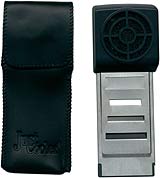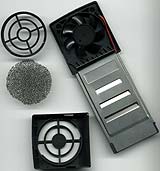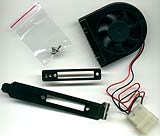
Just Cooler notebook, monitor and printer port coolers
Review date: 28 December 1999.Last modified 03-Dec-2011.
One of the distinguishing features of capitalism is that products evolve to fill market niches. What people will buy - or can be talked into buying - will be made, and then bought. It doesn't have to be good, it doesn't have to be useful, it just has to be wanted by someone.
Hence, weird-ass computer cooling products.
Cooling is important. There are various components of the modern computer that get hot - the CPU, the processors on modern video cards, and high speed hard drives, for instance. They're made to run warm, but they're not made to run too warm. If your CPU overheats your computer will crash; if your hard drive overheats you can lose data. At temperatures below the immediate-malfunction level, components can suffer shortened life spans; this is especially true of things with moving parts, like drives.
Accordingly, there's a big market for computer cooling products, most of which have one or more fans in them somewhere.
Just Cooler make some excellent, reasonably priced computer cooling gadgets; I review a selection of them here. But they also make some... niche... products.
Their NB-101 notebook cooler, which sells for the local equivalent of about $US25 from various dealers, is the best of the three I review here. The MC-100 monitor cooler is harder to love, and the FC-500PS printer port slot fan is... well, it's cute as a button.
On with the show.
NB-101
Forget efficiency and life span - laptops can be flat out uncomfortable when they're running at their normal hot-dog-warmer temperatures, if they're actually sitting on your lap. Better laptops are engineered throughout to tolerate alarming operating temperatures, as are the major components of even the cheapest current portables, but that doesn't mean those tiny hard drives and low-power CPUs actually enjoy broiling.
The NB-101 is a simple idea. You plug it into the PCMCIA (or "PC Card", as it's now supposed to be called, according to the Personal Computer Memory Card International Association) slot of a laptop, and it draws power like a normal PCMCIA device to spin its little fan and blow air into the laptop.
The little 50mm fan is rated, outrageously, at 38 cubic feet per minute (CFM) airflow. This is the kind of airflow you'd expect from an 80mm full-thickness fan in a free-air situation, not a 50mm slimline fan attached to a highly constrictive duct. If the NB-101 managed to blow 38 cubic feet - which is more than a cubic metre - per minute through the three narrow slots on the duct, the air would have to exit at something in the order of 110 kilometres per hour (70 mph)!
I think it's safe to say that someone just slipped a decimal point on the NB-101's spec sheet; three to four CFM seems a more reasonable figure for its performance, depending of course on how well ventilated your particular laptop's case is.
In any case, it moves some air, and the laptop will run significantly cooler, provided of course that the ambient air temperature is significantly lower than the temperature inside the laptop. If this isn't the case, I suggest you stop trying to compute spreadsheets in the middle of the Serengeti.
You also get a nice little leatherette case with the NB-101, to go with all of the other individually bagged goodies that inhabit the average portable computer user's Steal-Me Bag.
Will the NB-101 make a big difference to your laptop's stability? Maybe. Will it significantly extend the lifespan of the hard drive? Perhaps. Will it reduce the lap-scald factor somewhat? Yes. Using a laptop actually on your lap is something of an ergonomic disaster at the best of times, but the NB-101 will help a bit, and its dinky fan will make very little difference to the machine's battery life. Compared with the price of even a modest laptop, the NB-101 also has the advantage of costing approximately nothing.
Opening up the NB-101 doesn't exactly reveal captured Roswell technology. The grille that retains the filter foam is easily removed without detaching the whole fan housing, as I've done here.
UPDATE: This fan, and the various other products that look and work just like it, seem quite likely to not work at all if your laptop runs Windows 2000 or XP. Since the fan only connects to the PCMCIA slot's power pins, not any of the data ones, the computer doesn't think there's anything there at all, and doesn't power up the slot. I don't think this problem is solvable. Older portables power their PCMCIA slots all the time.
MC-100
Cathode ray tube monitors (as opposed to liquid crystal flat screens) certainly run hot. That big vacuum tube and its support electronics pump out the heat. Their standard cooling system is a simple passive affair; slots above and to the side of the tube (and, sometimes, below), with convection doing the job. A gentle waft of hot air comes out of the top of the monitor, and that's good enough.
Well, if that isn't good enough for you, say hello to the MC-100. For differing amounts less than $US20 depending on where you buy, it gives you active cooling for your monitor. Installation is simple enough; there's a plate that installs in any spare rear panel slot, with a cable that goes to a standard pass-though four-pin Molex power connector, which you can connect to any plug from your PC's Power Supply Unit (PSU). The pass-through connector means you don't lose a plug.
The plate has a Molex jack on it, and the MC-100 fan unit has a roughly two metre long lead which terminates in another Molex plug. Plug it into the jack and the fan spins whenever the computer's on.
The MC-100 mounts on top of pretty much any monitor by means of a simple, but perfectly adequate, little wire hook. The hook engages any handy cooling slot on the lid of the monitor, and four rubber feet stop the cooler from bouncing around. Earthquake-proof it ain't, but it does the job.
This cooler's an exhaust unit - it sucks air out of the monitor. As it should; if it tried to blow air in, it'd be fighting the natural upwards convection effect.
The MC-100's supposed to move 38 CFM, which is at least somewhat plausible; it's no doubt a free-air figure, again, but the top-of-monitor spot is not very restrictive, given the large vent areas on most monitors. The fan certainly pumps a reasonable breeze in actual use. And it's very quiet, too; the roughly 90mm fan spins at a lazy 2100RPM according to the spec sheet, and its noise barely beats that from a normal PC's single cooling fan.
But - why?
Computer monitors do fail, and I dare say some of these failures are a result of overheated components. But monitors are made to endure high temperatures for long periods - just look at the trouble-free years of service that most monitors, even low cost ones, deliver. Unless you live somewhere really, really hot, I'm unconvinced that the MC-100 will actually deliver significantly longer service than plain old convection cooling. I'm writing this in sunny Sydney, Australia, and we don't have monitors dropping like flies because of thermal failure. It might help if your monitor is sitting in direct sunlight and thus really offensively overheated as a matter of course, but in a situation like that you're likely to have a hard time seeing the picture on the screen.
Sure, get an MC-100 if you like. It's not like it's expensive, or anything, and unless you've already got a computer full of fans the extra load on the PSU's 12 volt line should be insignificant. But if you don't bother, I don't think you'll be missing much.
FC-500PS
And so to the comedy act of the trio. This little gizmo's a "slot fan" - it's made to move air through one of the slots on the back of a computer. There's nothing wrong with the basic idea of slot fans, but some of them are too small to achieve much of anything. This is one such unit.
The FC-500PS is rated at 9.5 CFM, which it might actually come close to achieving in a decently ventilated case; bigger slot fans, though, like Just Cooler's own FC-100 (reviewed in the comparison here) have three times this capacity. I'm inclined to suspect that this is another hopeful free-air figure, though; the housing around the FV-500PS's fan is quite restrictive, just by itself.
The FC-500PS's claim to fame is that you can mount it anywhere a printer port could go. Many cases have a spare printer port knock-out on the back panel; current ATX motherboards come with all of their ports in a block that pokes out of the back of the case, so the separate knock-outs usually remain unused. Pop out the cover on such a port-hole and you can screw the FC-500PS in place behind it; its screw holes have the standard 25 pin D-connector spacing. It also comes with a standard slot tab so you can mount it in any unused slot location, as well.
It's an exhaust fan, moving air from inside the computer to outside; you can't reverse the air direction, but you can mount the FC-500PS either way up, to draw air from one side or the other.
The FC-500PS plugs into your PSU with another pass-through Molex connector; like the monitor cooler, it doesn't use up a power plug. So far, so good.
But, again, why bother?
If you're crying out for just a little more ventilation, then this thing'll give it to you, but a weeny fan like this does so little that it's unlikely to make much difference to anything. And since it's exhaust-only, the air it moves past whatever you mount it next to has already passed over other warm components, and isn't nice and fresh from the outside.
I doubt that in a case that's already got a front-of-case fan installed you'd see much difference between installing an FC-500SP and just knocking out the cover of the spot where you'd install it, and letting the air flow through freely.
The only hot component that's close to a printer port opening in most current PCs is the CPU, which might benefit a bit from the FC-500PS's little breeze, but not nearly as much as it would from a serious change to the case ventilation. If you're going to use the slot adaptor and mount the FC-500PS as a regular slot fan, you'd do a lot better to get a regular slot fan, like the FC-100.
For around $US15, this fan does not much of anything.
Overall
If increasing your computer's fan count as an end in itself sounds cool to you, then monitor coolers and teeny-weeny slot fans will no doubt excite you no end. If actually making your PC work better is your goal, though, the little laptop cooler might perhaps help - if, of course, you have a laptop, and it doesn't run Win2000 or XP - but the other two seem unlikely to achieve much. Serious ventilation improvement can be had without too much effort - my over-the-top cooling project here also tells you how to crank up your airflow without hacking your case - but not everything actually needs extra cooling, and not every cooling product actually does something worthwhile.






